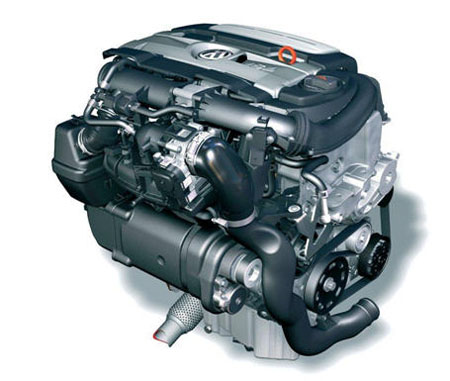(单词翻译:单击)
听力文本
This is Scientific American — 60-Second Science. I'm Christopher Intagliata.
If you've gone shopping for a car lately, you might have noticed that fuel economy—the number of miles per gallon—is slowly creeping up. One reason is a more efficient type of fuel injection, called gas direct injection. It's a feature of half the new cars sold in the U.S. last year.
"With that kind of engine design you can also introduce turbocharging—that's really what it comes down to: more engine power with a smaller engine." Naomi Zimmerman, an air-quality scientist at Carnegie Mellon University—who has, by the way, never owned a car. "Probably because I did a whole PhD on engine emissions."
Here's how the two injection methods differ. In the old standard, called "port fuel injection," gas is injected into the air intake, where it mixes with air before hitting the cylinder. In direct injection though, as the name implies, the fuel is injected directly into the cylinder. It's more fuel efficient, meaning lower CO2 emissions, which will help slow climate change. But here is a paradox, it also emits more particulate matter, including black carbon, or soot—a pollutant implicated in global warming.

Zimmerman and her colleagues analyzed studies of direct injection engines to see how this pollution tradeoff works out for the climate. "The answer is that it's really complicated and it's not certain." But on average, she says, boosting fuel economy five to nine percent would probably cancel out the warming effects of black soot, and score a net positive for the climate. The findings are in the journal Environmental Science and Technology.
The fuel economy goal might be different in places with big temperature swings, and where gasoline has more aromatic compounds—which seem to boost black carbon emissions. One place that fits the bill: Canada. "There we might need to be closer to the 10 percent, 15 percent mark in terms of improving fuel economy. Which is actually a very aggressive increase in fuel economy."
She says one solution that might reduce black carbon emissions is gasoline particulate filters. Which would also screen out particulate matter dangerous to human health. Meaning a win for the planet—and the people who live on it.
Thanks for listening for Scientific American — 60-Second Science Science. I'm Christopher Intagliata.
参考译文
这里是科学美国人——60秒科学。我是克里斯托弗·因塔利亚塔。
如果你最近买了一辆车,你可能已经注意到燃油经济,也就是每加仑行驶的总英里数正在悄然上升。原因之一在于燃油喷射装置的效率更高,这被称为缸内直接喷射技术。去年美国出售的新车中,有一半车辆都具有这个特征。
“这种引擎设计也可以引进涡轮增压,这才是真正的原因:更小的引擎,更大的发动机功率。”娜奥米·齐默尔曼是卡内基梅隆大学的空气质量科学家,她从未买过汽车。“可能是因为我在博士研究生阶段对发动机排放进行了整体研究。”
下面说明一下这两种喷射方式的不同之处。按照旧标准,车辆使用的是进气道燃油喷射技术,将气体注入进气口,在冲击汽缸之前与空气混合。而缸内直接喷射,顾名思义,就是直接式燃料喷射,将燃料直接注入汽缸。这种方法更省油,二氧化碳排放量更少,这将有助于减缓气候变化。但是,与此相矛盾的是,这种方法会喷射出更多的颗粒物,包括黑碳或煤灰等与全球变暖有关的污染物。
齐默尔曼和同事对直接喷射式发动机进行了研究分析,以查明这种污染均衡怎样解决气候问题。“答案是,这种方法非法复杂,目前还不能确定。”不过她表示,总体来说,将燃油经济性由5%提高到9%,可能会抵消黑炭的暖化效应,这对气候是有益的。该项研究结果发表在《环境科学与技术》杂志上。
燃油经济性目标可能在那些温度波动较大、汽油中含有更多芳香化合物的地方会有所不同,这似乎促进了黑碳排放。有一个地方刚好符合要求,这个地方就是加拿大。“在这里,就改善燃油经济性而言,我们可能需要将其提高至10%,甚至是15%。这确实是燃油经济性的大幅提高。”
她表示,汽油颗粒过滤器可能是减少黑碳排放的解决方法。该过滤器还可以筛选出危害人类健康的颗粒物。这意味着,这个星球以及生活在这个星球上的人们赢得了胜利。
谢谢大家收听科学美国人——60秒科学。我是我是克里斯托弗·因塔利亚塔。
译文为可可英语翻译,未经授权请勿转载!
重点讲解
重点讲解:
1. come down to (问题、决定等)归结为;
例句:It comes down to this: the man is a cheat.
事实是这样:那人是个骗子。
2. on average 基本上;大体上;
例句:On average, we use only 15 percent of our lung capacity, even during strenuous exercise.
一般情况下,人们即使剧烈运动也只用到15%的肺活量。
3. cancel out 抵消;
例句:He wonders if the different influences might not cancel each other out.
他在想,各种影响能不能相互抵消。
4. fit the bill 适合需要;符合要求;
例句:On paper, several of the applicants fit the bill.
从书面材料看,有几位申请人符合条件。
5. in terms of 在…方面;从…角度看;根据…来说;
例句:They have got all their ducks in a row in terms of how the company should be structured.
在应如何整合公司方面,他们已一切安排妥当。
6. screen out 筛选出;
例句:Unsuitable candidates were screened out.
那些不合格的候选人被筛选掉了。


